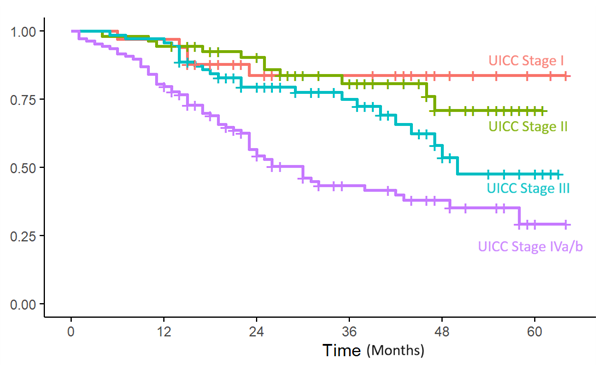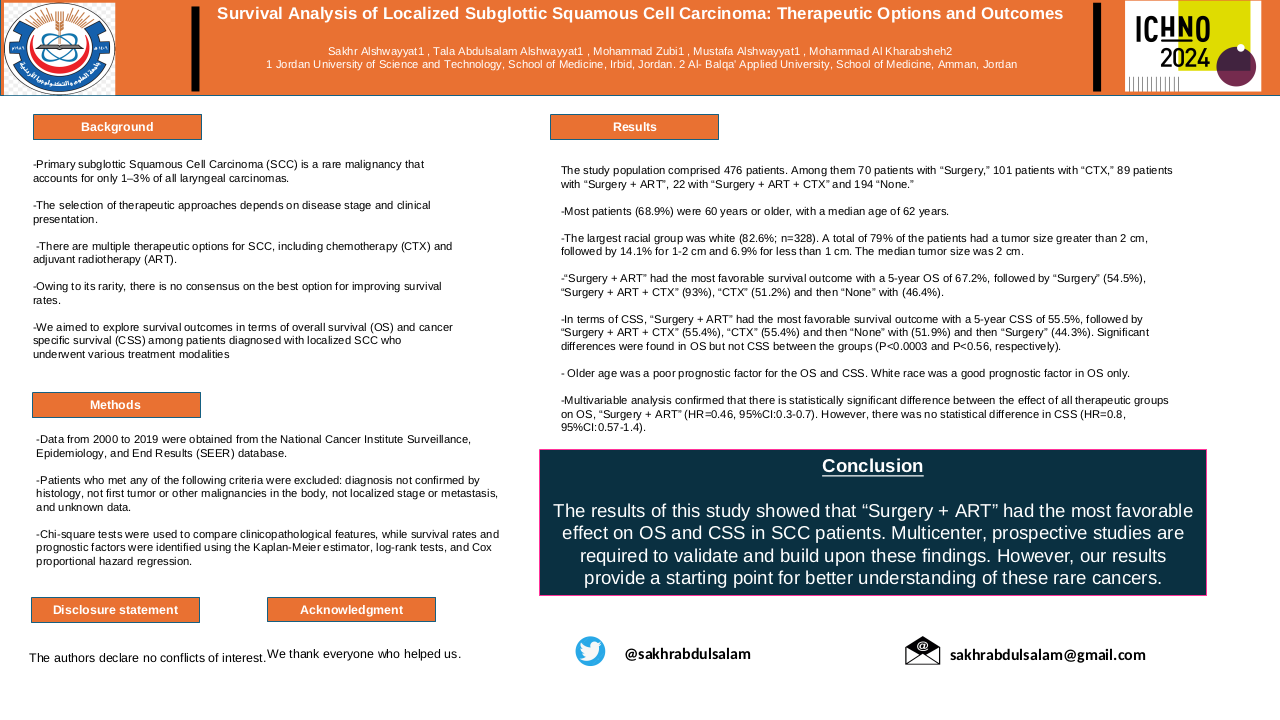The real world outcome of non-HPV head and neck cancer patients treated with definitive radiotherapy at a tertiary centre
Purpose/Objective
The assessment of cancer patient outcomes is important for any oncology departments. In head and neck cancer, not all patients are suitable for clinical studies. Unfortunately not all oncology centres are well resourced to undertake all available head and neck cancer trials. As a tertiary oncology unit with catchment radius of 50 miles and diverse patient demographics, it remains vital to assess outcomes of patients not included in formal studies. The aim of this study was to gather real world survival data of patients treated with definitive (chemo) radiotherapy.
Material/Methods
As standard of care, head and neck cancer patients are referred from 7 district general hospitals via 2 regional supra-multidisciplinary teams (sMDT). The data of patients demographics, and the clinical details of the head and neck cancer, are as routine collected prospectively for the institution electronic database. The date of disease recurrence on any patients is prospectively recorded at the sMDT.
Non-HPV mucosal head and neck cancer patients who received definitive radiotherapy outside clinical trials between Jan 2018 and May 2022 were retrospectively reviewed. All advanced stage patients (Stages III & IVa/b) were considered concomitant chemotherapy. Radiotherapy volume quality assurance was standard prior to radiation [1]. HPV-mediated oropharynx patients, as well those treated with post-operative or adjuvant radiation, were excluded. The progression free survival (PFS) were calculated from the prospective database, and the overall survival (OS) retrospectively from the institution main death register.
Results
A total of 267 patients were identified: 122 (46%) Larynx, 68 (25%) p16- Oropharynx, 34 (13%) Hypopharynx, 33 (12%) Nasopharynx, and 10 (4%) Nasal Cavity/Paranasal sinus patients. In terms of UICC 8th edition staging, there were 33 Stage I (12%) , 55 Stage II (21%) , 71 Stage III (27%) , and 108 Stage IVa/b (40%) cases across all tumour sites.
The median age was 65 (range 58 - 72). The male to female ratio was 3.2 to 1. Ninety percent (n = 240) of the patients had performance status of 0 or 1. Majority of the patients (n = 209, 78%) had had exposure to tobacco: 122 (46%) ex-smokers and 87 (33%) current smokers. The median smoking pack years for the tobacco exposed patients was 30 (range 10 - 40). As for alcohol consumption, 130 (49%) patients consumed at least 14 units per week, with 30 (11%) being non-drinkers. All patients received 65Gy in 30 fractions (f) over 6 weeks, unless they were T1/2N0M0 glottic cancer for which they received 55Gy in 20f over 4 weeks. A total of 107 patients (40%) had at least 1 cycle of concomitant chemotherapy with their radiation.
The median follow up was 3 years. Across all tumour sites, the 2 and 3 year PFS was 60% and 55% respectively, while the 2 and 3 year OS was 74% and 65% respectively. The OS probability according to the UICC staging across all disease sites is shown in Figure 1.
For the Larynx subsite, there were 26 Stage I (21%), 30 Stage II (25%), 51 Stage III (42%), and 15 Stage IVa/b (12%) patients. The 2 and 3 year PFS for larynx patients were 70% and 65% respectively, with the 2 and 3 year OS being 82% and 75% respectively.
For the p16- oropharynx cohort, there were 3 Stage I (4%), 12 Stage II (18%), 3 Stage III (4%), and 50 Stage IVa/b (74%) patients. In comparison to the larynx cohort, there were higher proportion of advanced stage patients in the Oropharynx cohort. As a result, the 2 and 3 year PFS for the p16- Oropharynx was 44% and 40% respectively, while the 2 and 3 year OS was 60% and 50% respectively.
As for the hypopharynx group, there were no Stage I (0%) but 3 Stage II (9%), 8 Stage III (24%), and 23 Stage IVa/b (68%) cases. The 2 and 3 year PFS was 40% and 25% respectively, while the 2 and 3 year OS was 55% and 42% respectively.
Separately, there were 2 Stage I (6%), 8 Stage II (24%), 8 Stage III (24%), and 15 Stage IVa (45%) Nasopharynx patients. The 2 and 3 year PFS for nasopharynx cohort was 75% and 60% respectively, with the 2 and 3 year OS being 78% and 70% respectively.

Figure 1 - Overall survival probability according to stages
Conclusion
Despite varying tumour sites, the OS of patients overall corresponded to the UICC Stage of their disease, indicating the importance of accurate initial staging as part of prognostication.
[1] Chiu K, Hoskin P, Gupta A, Butt R, Terparia S, Codd L, Tsang Y, Bhudia J, Killen H, Kane C, Ghoshray S, Lemon C and Megias D 2021 The quantitative impact of joint peer review with a specialist radiologist in head and neck cancer radiotherapy planning Br. J. Radiol. 20211219






